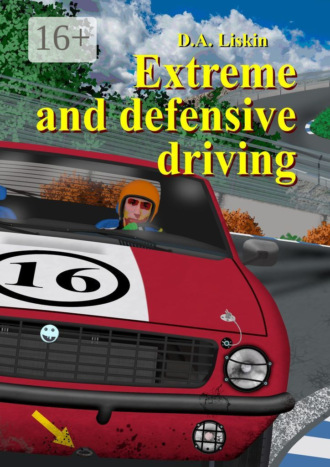
Полная версия
Extreme and defensive driving. 2nd expanded edition
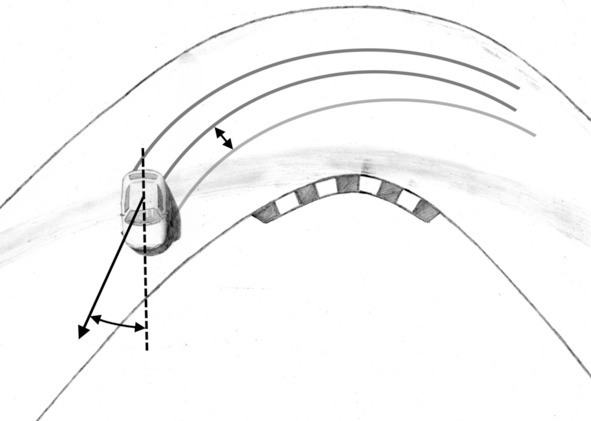
Besides drift angle, steerability can be evaluated by passing the following test.
Test of steerability. Gain certain speed, press the clutch pedal and quickly turn the steering wheel to fixed angle. After vehicle is rotated 180 degrees, determine the distance between the starting and ending positions of car.
Let us run this test on the hatchback and measure distance between initial and final trajectories.
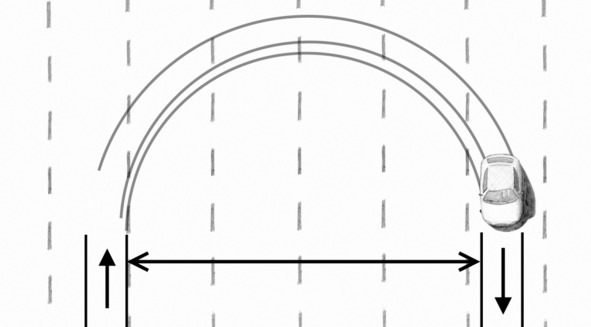
As result the distance was slightly more than four lanes. If the greater distance obtained in the test, therefore, lower steerability. After changing vehicle settings (for example, spring rates, stiffness of antiroll bars), you can repeat the test and compare the results. Initial speed and turn angle of the front wheels must be the same. Steerability, which we have determined by methods described in this chapter, we will call steerability or steerability of coasting motion.
In the tests we turned the steering wheel against stop (angle of turn of the wheels is about 40 degrees), the front wheels slide. If you turn the front wheels at a smaller fixed angle (10—15 degrees), drift angle (steerability) will be higher, since load on the front tyres will be less.
With help of the controls, you can increase or decrease steerability. For example, if you press hard on the throttle pedal on rear wheel drive car while cornering, the rear axle can easily slides. That is pressing the throttle pedal on rear wheel drive car leads to acceleration not only, but also increases steerability. On front wheel drive car, on the contrary, pressing the throttle pedal causes car to straighten trajectory – this is effect of reducing of steerability. Oversteer (high steerability) may be created by using the handbrake: it is often possible to see drivers in rally races enter the hairpins with sliding of the rear axle, locking the rear wheels.
Steerability created with help of the controls will be “added” to the vehicle’s steerability. Let us say if car has very low steerability, it will be more difficult to send it into drift due to traction on the rear axle than car with high steerability.
Exercise. Try to determine steerability of your car. For this purpose you may place cones on ground that simulate a corner and do the test. Do not forget about safety: car can show very low steerability, or it can start slide and turn around, so there should be enough space on the ground.
Be careful! Incorrect “tuning” of car (it may be suspension parameters, track, ground clearance) can make your car unsafe. Manufacturers design passenger cars in such way that they are stable and do not roll over during sudden maneuvering. If there is a risk of overturning in a corner, turn the steering wheel against the direction of the corner to return vehicle to the four wheels.
It is worth noting that electronic drive control systems, electronic control of torque distribution on the wheels, dynamic electronic motion stabilization systems can distort perceived steerability of car.
Drift: causes of origin and methods of fighting
When the front axle slides, we lose control. Unlike understeer, drift – is a controlled sliding of car. There may be one or both axles in the slide. Tendency to drift and behavior of machine when drift are influenced by such parameters as the type of drive, steerability, the type of differential. During drift, the rear axle tends to bypass the front. For clearness, if longitudinal direction of the body deviates to the right from direction of movement, we will say that car drifts to the right (drift direction is to the right), and angle between direction of movement and longitudinal direction of the body will be called drift angle.
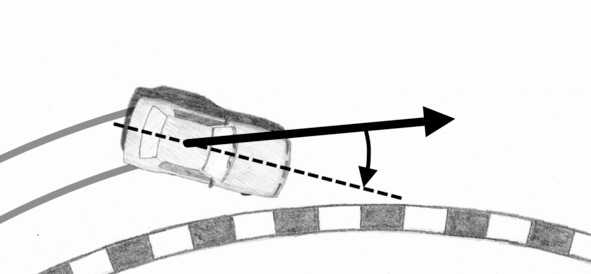
This rear-wheel-drive car is specially prepared for drifting. It is equipped with limited slip differential, high torque motor, negative camber of the wheels and an increased full lock angle of the front wheels. On a front-wheel-drive car it is may be easily get out of any angle of drift, if engine torque is sufficient to maintain skid of the front wheels. For example, on this car, we entered and exited drift several times one after another.
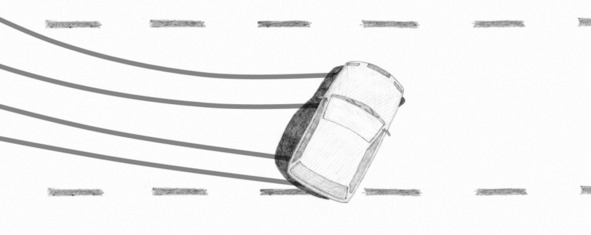
The sliding behavior of an all-wheel-drive car depends on distribution of the torque among the axles. If main part of the torque is applied to the front axle, behavior of car will be close to behavior of a front-wheel-drive car. This all-wheel-drive car feels like a front-wheel-drive car: when pressing the throttle pedal the car tends come out of drift.
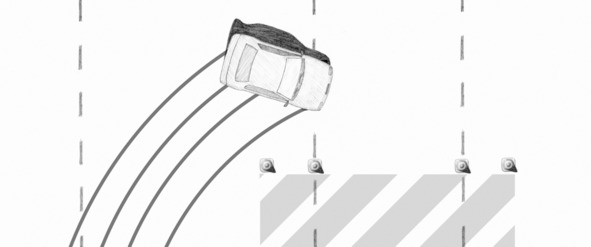
But unlike front-wheel-drive, on all-wheel-drive car it is possible to maintain stable drift due to part of engine torque transmitted to the rear axle. In addition it is easier to maintain a slide on all-wheel-drive car than on rear-wheel-drive car (with an appropriate ratio of the torques transmitted by the engine to the front and rear axles), since traction on the front axle will not allow car to turn around.
It is worth noting, that when drive in reverse when turn the steering wheel the front axle can drifts. We accelerated in reverse and quickly turned the steering wheel, whereupon the car turned almost 180 degrees.
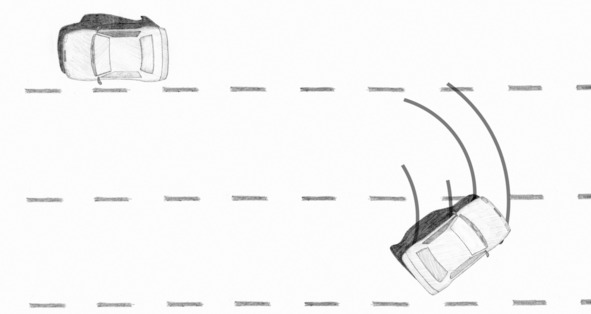
Inability to drive car in a drift often leads to accidents. Rear-wheel-drive car with usual differential (zero or low friction) is quite difficult to drive in a drift. Take for testing a rear-wheel-drive car with zero-friction differential (factory) on the rear axle. Let us look at what may be causes of occurrence and ways to provoke rear axle drift.
1. Braking by handbrake. It is the simplest and most understandable cause.
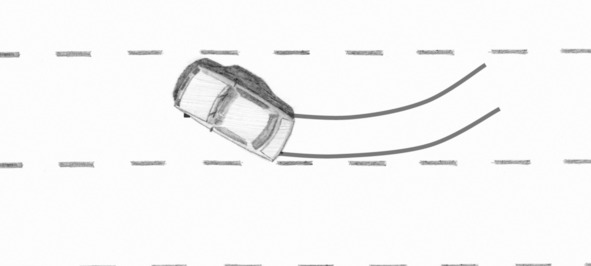
2. Aggressive throttling on a rear-wheel-drive car. Please note – with a standard differential the first starts to skid wheel from the inside of corner (the unloaded wheel).
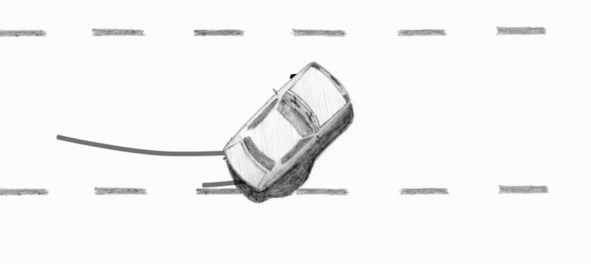
3. Speeding of engine and depressing the clutch on a rear-wheel-drive car. If you push the clutch, gain engine speed and, without releasing the throttle, release the clutch, the rear wheels will skid.
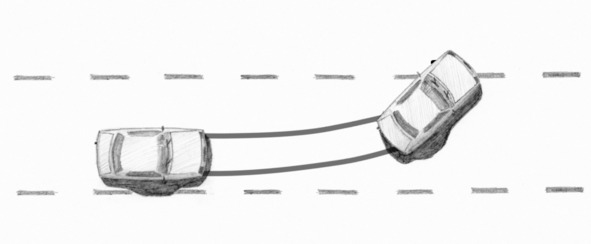
We revved up the engine and casted off the clutch pedal. The both rear wheels began to skip, the rear axle began to drift.
4. Engine braking on a rear-wheel-drive car. When the throttle pedal is released, firstly, the front axle is loaded and the rear – is unloaded.
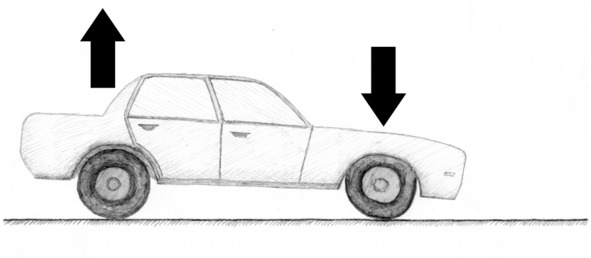
Because of this grip of the front tyres with the road increases, the rear – decreases. Secondly, there is a braking effort on the rear wheels caused by engine braking. These facts lead to increase of steerability and can cause drift when maneuvering on a rear-wheel-drive car, especially on a high steerability car. Soft braking with engine braking together can have the same effect. In addition, roughs on the road unload the rear axle awhile, which combined with engine braking increases risk of sliding on a rear-wheel-drive.
5. Downshift without throttle blip on a rear-wheel-drive car with a manual gearbox. After lowering the gear and releasing the clutch pedal the engine is forced to gain speed in a short time distance, which can be indicated by a jump of the tachometer needle. On rear-wheel-drive, this is equal to action of the handbrake.
6. Braking with a strong shift of brake balance to the rear axle. When balance of the braking system is shifted to the rear axle, steerability may increases during braking. It may happen that the rear wheels will be first to brake.
7. Rocking the center of mass. Rocking can cause drift when passing an S-like corner.
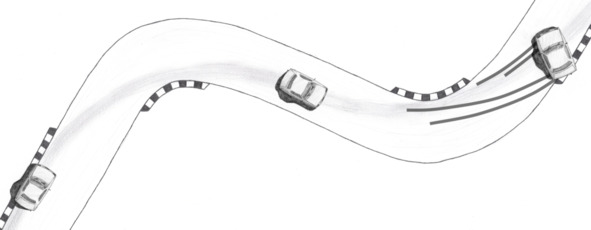
When direction of movement changes, the energy stored in the compressed suspension, is freed and pushes car in opposite direction, which can lead to drift.
8. Together pressing the throttle and brake pedals on a front-wheel-drive car. Moving along the ring on a front-wheel-drive car, let us press the throttle and brake pedals at one time.
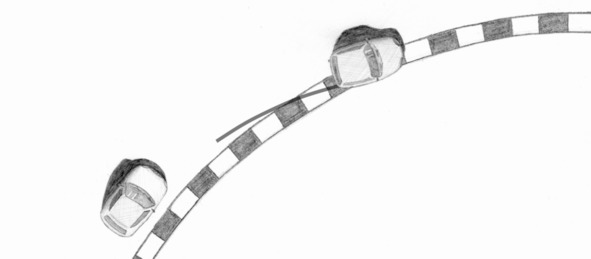
There was drift of the rear axle, the car rushed inside the ring. That is, the pressed throttle and brake pedals on a front-wheel-drive car create oversteer. Since we pressed on the throttle when braking, there was traction from the engine on the front axle. The rear axle brakes more intensively than the front, not exclude the rear wheels may be locked. Braking by the rear wheels creates oversteer, which is similar to braking by the handbrake. To describe operation of the front axle we take into account the several factors:
• due to the roll in the corner the left wheels were loaded with mass of the car, and the right wheels were unloaded;
• the front wheels are affected by the engine torque and braking effort;
• the engine torque is divided between the front wheels by the differential.
On the front axle of the car a zero-friction differential is installed, which transmits half of the engine’s torque to the each wheel. To explain the test results, we assume that the engine torque is enough to maintain traction on the front wheels when the brake pedal is pressed full way down.
For demonstrativeness of illustrations we introduce the concept of equivalent force. Equivalent force is the force that must be applied to the top of wheel to obtain the torque on wheel (this may be engine torque or torque generated by a braking system).

The figure shows the force was applied to the top of the wheel and compels the wheel to rotate faster clockwise.
Let us draw equivalent forces that occurred when one time press the throttle and brake pedals in the previous test.
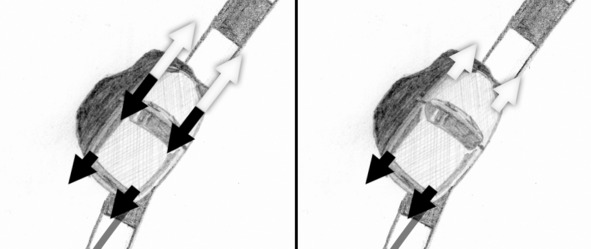
At the left figure black arrows indicate equivalent forces created by braking system, white arrows – equal equivalent forces corresponding to torque produced by the engine and is divided between the wheels by differential. The right figure shows the resulting equivalent forces on each front wheel, which corresponds to the resulting torque (difference between engine torque and brake system torque). We did not press the brake pedal to the end, the braking effort on rear loaded wheel was not enough to lock it.
If braking effort is high enough, the rear wheels may become locked. Let us imagine a case when the rear wheels are locked. Note the locked wheels with crosses.
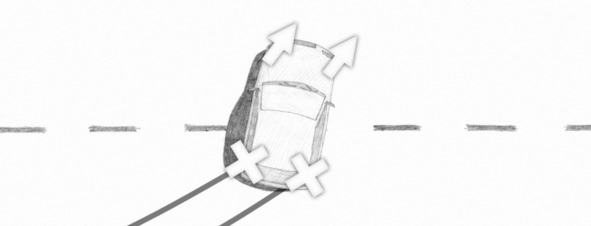
Direction of the equivalent forces corresponds to direction of movement of the front wheels. Front unloaded wheel has worse grip on the road than the loaded one, and there is a chance that it starts to slip. If the unloaded wheel starts to skid, the main part of the engine’s power will be transferred to it.
Although pressing the throttle and brake pedals creates oversteer on a front-wheel-drive car, steerability may be reduced by engine’s torque. If the rear wheels are locked, but the engine has an enough high torque, car will not turn around in a drift due to high traction on the front wheels. At the same time, if braking effort on the front wheels is fully compensated by the engine torque, maximum steerability will be achieved.
Increased friction of differential allows you to transfer more torque to loaded front wheel and thus more efficiently implement engine power. Let us represent equivalent forces, when a limited slip differential is set on the front axle.
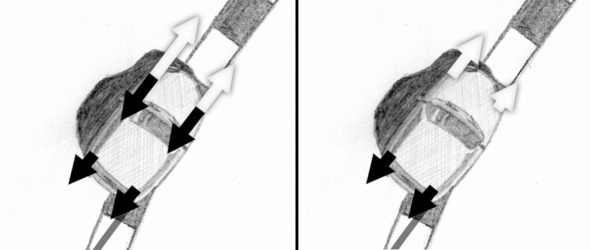
The left figure shows equivalent forces generated by braking (black arrows) and engine torque (white arrows). Figure on the right shows resulting equivalent forces on the front wheels after subtracting the braking effort from engine torque. A greater amount of torque on loaded front wheel means that more engine power will be transferred to the wheel compared to situation, when a zero-friction differential was installed.
Thus, traction on the front wheels when braking creates oversteer. Presence of a small traction on the front wheels during braking is equivalent to shifting balance of braking effort to the rear axle. But too much traction on the front wheels can lead to straightening of trajectory (understeer).
In addition to the previous reasons, drift can be caused by a sharp change in the road surface. For example, if a driver inadvertently drove a rear wheel to wayside of the road on which there is ground or snow, car can drift. An inexperienced driver, as a rule, does not operate with information about condition of the road surface and how it should affect the braking path and control technique. If you move in the “normal” tempo, familiar for dry weather, a rear-wheel-drive car can easily start drift at exit of corner on a wet road. Another danger may be invisible ice under the snow. Unsuspecting driver moving quite calmly on the road or passing a corner, can hit into emergency situation.
You can create oversteer in all the ways that you can create rear axle drift. For example, shifting the brake balance to the rear axle will increase steerability when braking at entry to a corner. On a front-wheel-drive car steerability can be improved by using the throttle and brake pedals together.
Ways to go out of drift
Front-wheel-drive
Consider ways to get out of drift. At first consider the front-wheel-drive type. We will provoke drift by the hand brake. When the rear axle begins drift, we must press the throttle pedal to 100% and direct the front wheels against direction of drift to stop the drift.
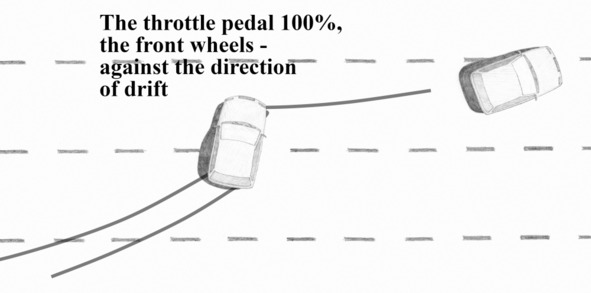
There are noticeable traces left by locked rear wheels during the action of the handbrake. The first was locked the unloaded wheel. After the end of handbrake action, the throttle pedal was pressed and the steering wheel was turned against of the drift direction. It may be seen unloaded front wheel began to grind after pressing the throttle pedal. This is explained by the fact the machine has a zero-friction differential. Before the end of the drift the steering wheel was returned to the “straight” position, after the throttle pedal was released.
The psychology of an untrained driver forces him to release the throttle pedal when a drift occurs, regardless of the drive type. This is a common error in driving a front-wheel-drive car. Finding himself in an unfamiliar situation, overcame by sense of fear, the driver releases the gas pedal. So the drift increases. Eventually, driver loses control over the car, the car continues to move by inertia, as if there is no driver in it.
For successful exit from any angle of drift on a front-wheel-drive car engine torque must be enough, to keep skidding of the front wheels at least on the first gear, otherwise the engine will fail. If drift angle of 90 degrees or more occurs it is likely, that you will have to lower the gear, to increase torque on the front wheels.
Rear-wheel-drive
On a rear-wheel-drive car the throttle pedal must be released when exiting from drift. Let us take a rear-wheel-drive understeer car. We will provoke drift of the rear axle by pressing the throttle pedal roundly when passing a corner. To stop drift, depress the throttle pedal and turn the steering wheel against of drift direction. When drift begins to decrease, we will immediately return the steering wheel to the “straight” position.
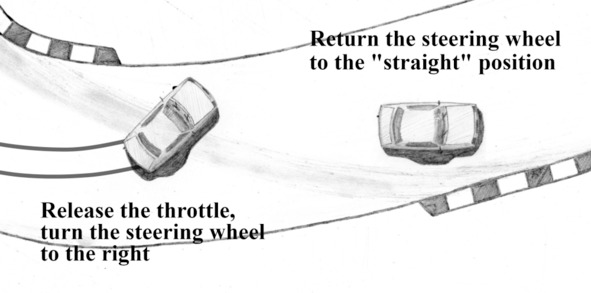
When exiting a drift with help of steering the maximum drift angle from which you can exit depends on the maximum turn of the front wheels. Note that during exit from drift, the front wheels of the car are directed along the direction of movement. If a zero-friction differential is installed on the rear axle and no friction is created inside the differential when negative load, then braking by the engine will create noticeable oversteer. Therefore, in the case of zero-friction differential, it is better to squeeze the clutch during fight with drift, to exclude engine braking.
At next, we will try an experiment. Let us see, what happens if press together the throttle and brake pedals, while the car is in a drift.
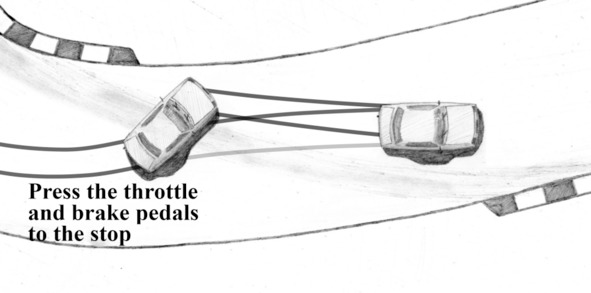
During pass the corner we provoke drift by throttling. Then we hit the throttle and brake pedals at the same time. The front wheels were locked, and there was traction from the engine retained on the rear wheels. Rear unloaded wheel began to skid. Trajectory straightened and drifting stopped. There are visible tyre traces, left by locked front wheels and unloaded rear wheel, which slipped on the asphalt.
Consider what happened to each axle when the throttle and brake pedals were pressed together. Since the drive is carried out on the rear wheels, the front wheels will only be affected by the braking effort, which causes the front wheels to lock. Locked front wheels cause understeer. Now let us look at what happens to the rear axle. For now imagine, that the rear axle has a zero-friction differential. The rear wheels will have braking efforts and equal engine torques.
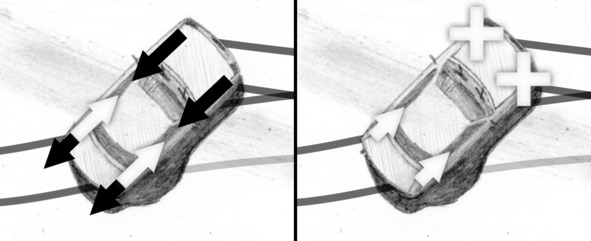
The left figure shows equivalent forces, created by braking (black arrows), and equivalent forces, caused by engine torque (white arrows). At the right figure the resulting equivalent forces on the rear wheels are shown in white arrows. High braking effort on the front wheels locked them. On the rear axle a small traction was retained. As you know, traction on the rear wheels leads to loading the rear axle and unloading the front. To lock the front wheel is easier, when the front axle is less loaded. As a result, conditions for understeer are created.
The torque on the rear axle can be adjusted so that the braking effort is compensated: neither traction nor braking effort will act on the rear wheels. In this case only the front wheels will brake, which is similar to a strong shift of brake balance to the front axle. As for power, it is distributed unevenly between the wheels: zero-friction differential transfers the main part of engine power to the unloaded wheel.
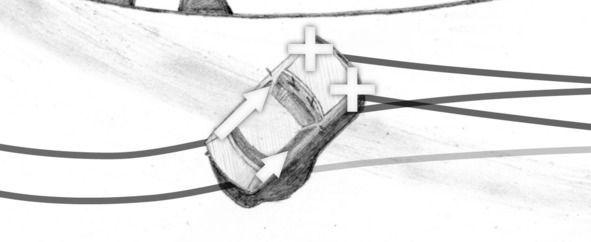
At the figure the arrows show the power transmitted to the rear wheels.
The torque on unloaded rear wheel causes it to spin rapidly and skid on the road surface. When the trajectory gradually straightens and roll of the body decreases, the unloaded wheel regains grip on the road, speed of rotation gained by it decreases sharply. At that there is a push against the direction of drift, which causes the trajectory to straighten even more.
If a high-friction differential is installed on the rear axle, more engine torque will be transmitted to rear loaded wheel, than to rear unloaded wheel. When the throttle and brake pedals are pressed at the same time, there will be less understeer, than in the case of a zero-friction differential, since the increased torque on rear loaded wheel will push the car in the direction of increasing drift.
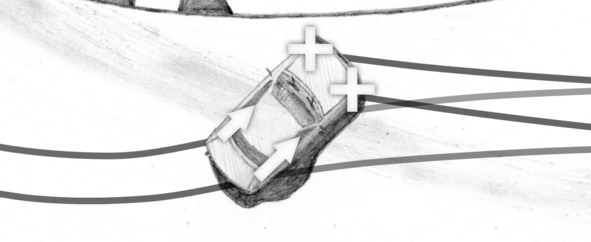
The figure shows the total equivalent forces, when a high-friction differential is installed on the machine. A high-friction differential transfers more than half of engine’s torque to rear loaded wheel. The increased traction on rear loaded wheel pushes the car even deeper in the direction of drift (to the left in the figure plane). An addition increase of the torque on rear loaded wheel leads to an increase of engine power transmitted to this wheel.
Thus, the same time pressing the throttle and brake pedals on a rear-drive car creates understeer and allows you to get out of drift. In the future this method of fighting with drift on a rear-wheel-drive car will be called a defensive “throttle+brake” technique. As a rule, at drift angle of approximately 45 degrees (the angle must be checked for each car) and more “throttle+brake” technique does not work, since traction on rear loaded wheel causes car to turn around.
It is important to understand, that “throttle+brake” technique forced a car to move straight. When performing the technique drifting stops, the machine continues to move in a straight line in the same direction, in which it was moving before performance the technique. Therefore it is necessary to calculate trajectory and duration of “throttle+brake” pulse. If a driver has reacted to drift in time, a short impact on the brake pedal and steering correction may be enough. Note, that “throttle+brake” technique allows you to get out of drift, without turning the front wheels.
Since the front wheels are locked, it does not matter, which way they are turned. But to successfully take control at the end of the technique, when the front wheels are in locked condition, you should put the steering wheel straight. There are two reasons for this:
• the suspension geometry is such, that when the front wheels are turned by the steering wheel, the front of car come down; the straighten wheels will lift the front of car back; the greater front clearance – the lower steerability;
• if the front wheels are set in the straight position, car will remain neutral behavior after releasing the throttle and brake pedals (the car’s behavior will not change).
At the end of “throttle+brake” technique it is enough to align trajectory with a corrective steering. If it is necessary to avoid an obstacle or bend trajectory because of other reasons, you should turn the front wheels previously, during perform the technique, when the front wheels are locked.
The torque transmitted to rear loaded wheel depends on engine torque. If engine torque is high enough, efficiency of “throttle+brake” technique may fall: when together pressed the throttle and brake pedals the rear wheels start to skid. In this case to exclude skidding of rear loaded wheel, you should limit effort on the throttle pedal during performance the technique.
For “throttle+brake” technique to work on a rear-wheel drive car, the brake system must be properly configured. It is necessary, that both front wheels are locked when the brake pedal is fully pressed both when moving forward in a straight line, and when passing corners to the left and right or when the car is in a drift. In addition, the braking effort on the rear wheels should not be too high, and engine torque should not be too low. If the rear wheels will be locked, the engine will stall.
Requirements for successful exit from a drift on a rear-wheel-drive car with help of “throttle+brake” technique
• both front wheels must lock when the car is in a drift;
• the rear wheels must not be locked;

